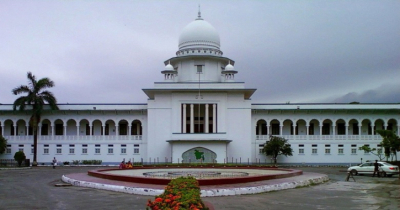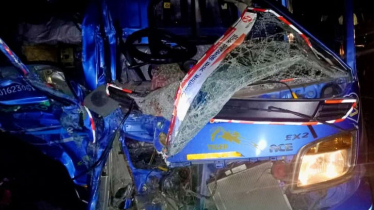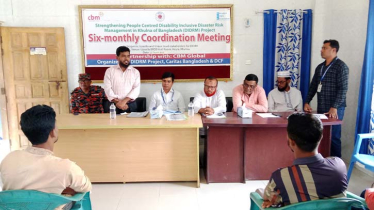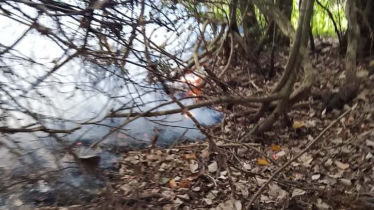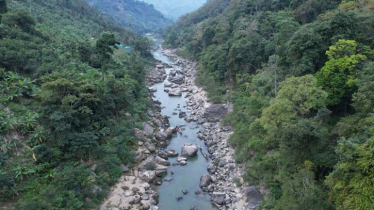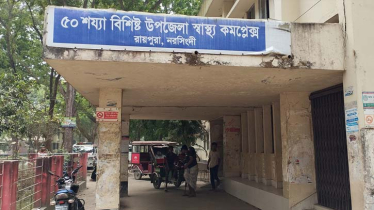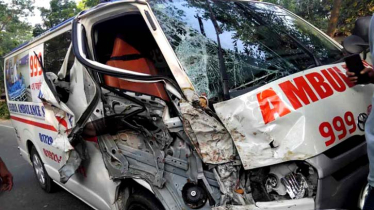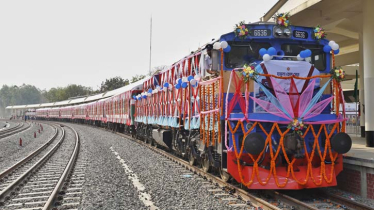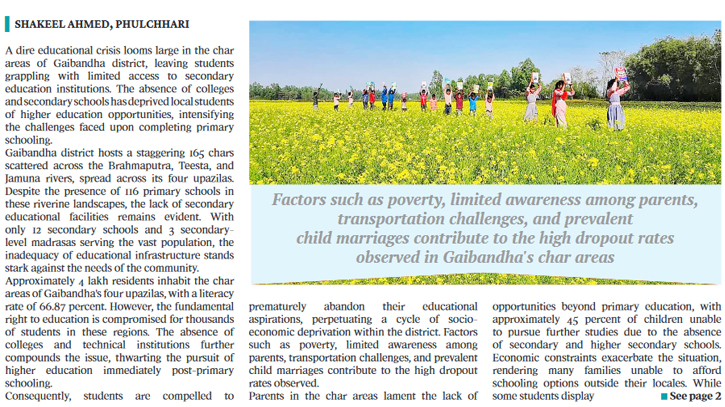
A group of schoolchildren is crossing through a mustard field, holding their books above their heads. Photo: Messenger
A dire educational crisis looms large in the char areas of Gaibandha district, leaving students grappling with limited access to secondary education institutions. The absence of colleges and secondary schools has deprived local students of higher education opportunities, intensifying the challenges faced upon completing primary schooling.
Gaibandha district hosts a staggering 165 chars scattered across the Brahmaputra, Teesta, and Jamuna rivers, spread across its four upazilas. Despite the presence of 116 primary schools in these riverine landscapes, the lack of secondary educational facilities remains evident. With only 12 secondary schools and 3 secondary-level madrasas serving the vast population, the inadequacy of educational infrastructure stands stark against the needs of the community.
Approximately 4 lakh residents inhabit the char areas of Gaibandha's four upazilas, with a literacy rate of 66.87 percent. However, the fundamental right to education is compromised for thousands of students in these regions. The absence of colleges and technical institutions further compounds the issue, thwarting the pursuit of higher education immediately post-primary schooling.
Consequently, students are compelled to prematurely abandon their educational aspirations, perpetuating a cycle of socio-economic deprivation within the district. Factors such as poverty, limited awareness among parents, transportation challenges, and prevalent child marriages contribute to the high dropout rates observed.
Parents in the char areas lament the lack of opportunities beyond primary education, with approximately 45 percent of children unable to pursue further studies due to the absence of secondary and higher secondary schools. Economic constraints exacerbate the situation, rendering many families unable to afford schooling options outside their locales.
While some students display immense talent, their prospects are hindered by the absence of educational facilities in the char areas. Despite the adversity, there are instances of students from Gaibandha's char areas excelling in prominent educational institutions across Bangladesh, underscoring the potential for academic success if given adequate support.
Given the frequent impact of river erosion on the chars, the establishment of temporary secondary schools is proposed as a measure to mitigate premature dropout rates. As education is a fundamental right, ensuring equitable access to educational opportunities for all remains imperative for societal progress.
Local Member of Parliament, Mahmud Hasan Ripon, assures that the government is committed to uplifting marginalised communities, prioritising the development of educational infrastructure in char areas. Efforts are underway to address the educational deficit and pave the way for a brighter future for the students of Gaibandha's riverine landscapes.
Efforts to address the educational crisis in Gaibandha's char areas are gaining momentum, with stakeholders advocating for sustainable solutions. Community leaders stress the importance of government intervention to establish colleges and secondary schools, providing a pathway for higher education locally. Additionally, initiatives to enhance awareness about the significance of education and combat socio-economic barriers are underway.
Civil society organisations are actively collaborating with authorities to implement educational programmes tailored to the needs of char residents. Through concerted efforts and collective determination, strides are being made to ensure that every child in Gaibandha has access to quality education, regardless of their geographic location.
Messenger/Fameema

